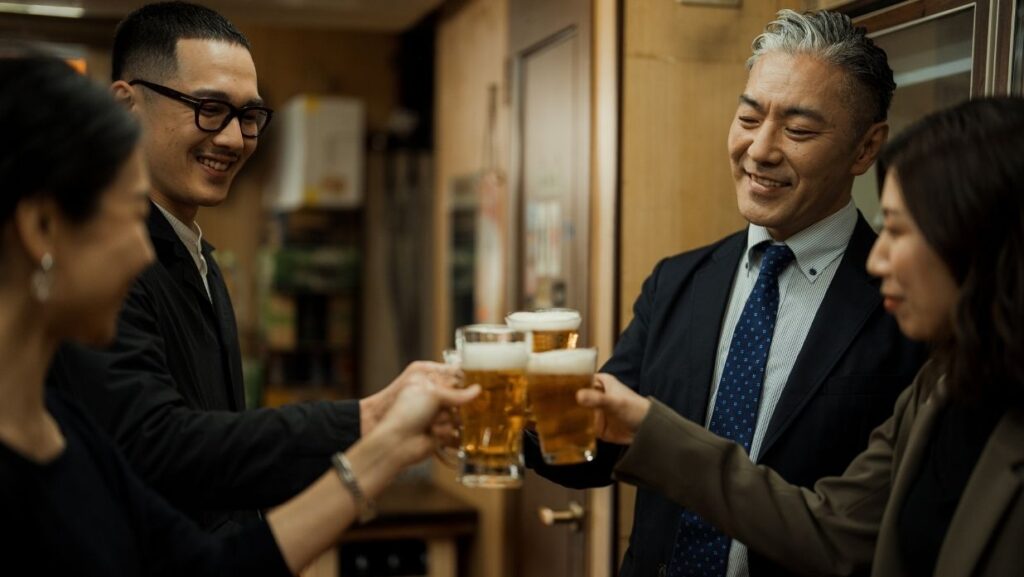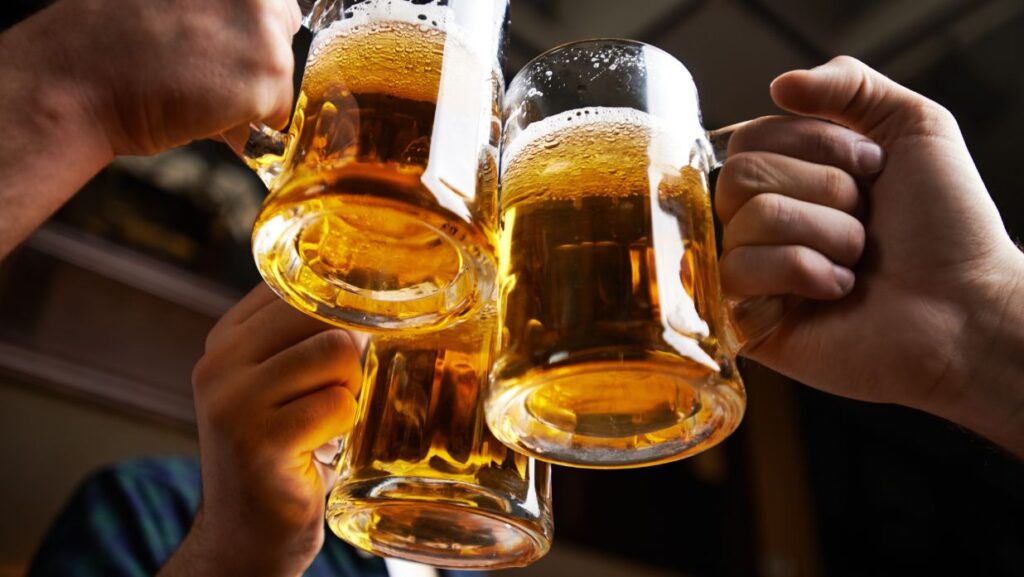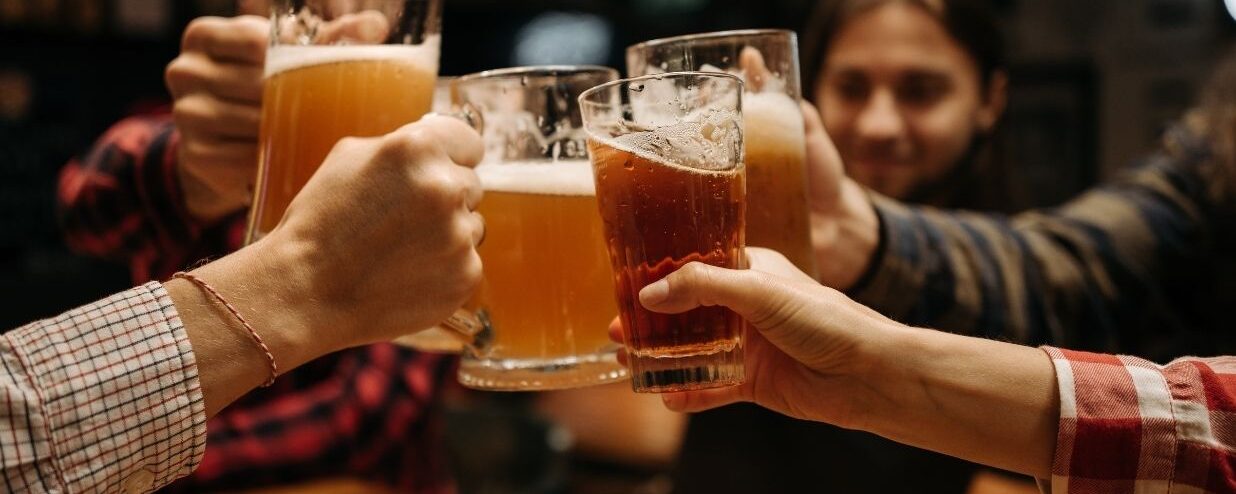Kanpai! You have probably heard this word cheerfully hollered at bars or even among your Japanese friends. So, what does kanpai mean and when do you use it? Are there specific manners for saying kanpai in Japan?
It’s undoubtedly a part of the drinking culture that has developed in Japan over hundreds of years. So, let’s explore Japanese drinking culture and etiquette, what to avoid, and how to make a proper toast to your friends, colleagues, or family!
Kanpai (杯): What does it mean?
乾杯 (Kanpai) is the Japanese equivalent of “cheers.” The word kanpai originally comes from Chinese, so similar terms apply in Mandarin (gan bei), Cantonese (gom bui), and Korean (geonbae). Breaking down the word, 乾 (kan) is dry, and 杯 (pai) is cup.
So, kanpai literally translates to “dry cup” or even “bottoms up”, implying chugging down your whole drink. However, in most cases, the intention is just to clink glasses and take a sip; chugging down the whole drink isn’t a requirement.
Of course, you don’t need to be drinking sake or beer to say “Kanpai!” Even non-drinkers will often raise a glass of tea or a soft drink just for the sake of joining the toast.
History of kanpai culture
The culture of toasting before taking a sip might have existed for as long as alcohol has in Japan. In ancient Shinto traditions, one would toast their sake to the gods and the dearly departed. This is due to the belief that sake is the drink of the gods, so you would do a toast since you are sharing a drink with the gods.
There’s a theory that, in ancient times, people would pour a little sake into each other’s cups and drink together to prove the sake wasn’t poisoned — a show of trust. Interestingly, in Europe, it’s said that clinking glasses during a toast was meant to drive away any evil spirits lurking in the drink.
The actual use of the word kanpai came much later and may have originated at the signing of a friendship treaty between England and Japan in 1854, during the Edo Period.
During a party, the Earl of Elgin asked his diplomatic partner, Kiyonao Inoue, to offer a toast to the King, as was customary in England. In response, Inoue suddenly stood up and loudly declared, “Kanpai!” The unique expression delighted the British guests, sparking laughter and leaving a memorable impression.
Afterwards, the word caught on and started to be used for any occasion to make a toast, leading to the culture of kanpai we have to this day.
When to use kanpai

Whether you are out drinking at an izakaya with friends or with your company, you might say kanpai before taking a sip. You can use it for both formal and casual events. However, there might be some customs specific to your company’s work culture to be aware of. Some companies will have higher-ups or managers start the kanpai, while others might be much more casual.
Often when drinking with colleagues, you may say otsukaresama instead of or in conjunction with kanpai to show gratitude for each other’s hard work.
Kanpai is also often said for a toast, especially for certain celebrations. You might say kanpai to celebrate your friend, so you could say something like ジョンさんに乾杯!(jon san ni kanpai) or “let’s toast to John!”. Or even to honor a group of people, like those who just joined a company or a team who just finished a sports tournament.
How to kanpai in Japan
So, how exactly do people kanpai in Japan? You might picture weathered salarymen gathered around a table after a long day at the office, or toasting with a geisha wearing a kimono. Contrary to that, kanpai culture is now very approachable, becoming less of a ritual and more of a habit equivalent to saying cheers.
Toasting is a common practice at restaurants and izakaya, but the traditional shout of kanpai is heard less often, especially among younger generations, who have embraced a more casual drinking culture.
In both casual and formal settings, it’s considered good manners to wait for everyone to receive their drinks and say kanpai together. Here are some general guidelines to keep in mind:
- Wait for everyone to have a drink in hand and then say “kanpai!”
- Raise your glass with a smile, especially in group settings.
- Click the glass gently.
- Don’t drink before the toast since it could be considered rude.
At more formal occasions, such as company parties or when going out for drinks with coworkers, there are some unwritten rules to kanpai etiquette. It’s generally considered polite to slightly lower your glass when toasting with people who are more senior than you — the most senior person, like the boss, should hold their glass the highest. This means that if you’ve just joined the company, your glass will be held slightly lower than everyone else’s.
At larger events with multiple tables, you might also see people walking around to toast individually with others at different tables. To make a good impression, don’t hesitate to approach them and join in the kanpai!
Drinking Etiquette in Japan
Japanese culture has many customs and unspoken rules of etiquette, and this extends even to nomikai in Japan. In a formal setting with your work colleagues or with clients, drinking together is meant to loosen up a bit, but not completely.
Displaying proper etiquette even while drinking will help to enhance your impression with colleagues and higher-ups. It might be a chance to show your respect to them as well. Even outside a work context, when drinking with your sports team, for instance, you should show greater respect to your senpais and coaches. So, here are some tips for displaying the best etiquette possible.
1. Pour drinks for others
It’s polite to pour for your neighbor, especially seniors or coworkers. Although it is customary for the younger or less experienced to pour, nowadays, your seniors will pour for you as well. But always be on the lookout for empty glasses.
When pouring for others (especially in a formal setting), use both hands and clearly show the label side of the bottle. This allows the receiver to properly understand what they are being served.
2. Try not to serve drinks to yourself
It is considered proper manners to wait for someone to serve you a drink rather than helping yourself. When someone pours for you, hold your glass with both hands and tilt it in the direction of the person serving you. This just makes it easier for them to pour.
If no one is noticing your empty glass and you’re craving a bit more to drink, just simply pick up your glass and ask someone to top you off. You can simply say お願いします (onegaishimasu) or もう一杯お願いします (mou ippai onegaishimasu), which just means, “One more, please.”
3. Wait for kanpai before drinking
Generally, you should wait to kanpai before consuming anything, as it might be considered rude, especially if it’s an alcoholic drink. If you’re a bit parched and need some water, it probably won’t be considered rude to have a sip before doing the kanpai.
However, if you don’t drink alcohol and prefer just having water, there might be some Japanese superstitions surrounding kanpai with water. There are some older traditions around water and purification, so doing a toast with a glass of water may signify a final goodbye.
But, in general, people are becoming more flexible and will understand that not everyone drinks alcohol or even soft drinks. So, people will probably make the exception to let you kanpai with water or at least a drink to hold, but not need to actually consume.
Understanding Japanese Drinking Culture

Drinking in Japan is about more than, well, the drinks. It’s about socializing, making bonds, and team building (in the case of colleagues). In Japan, whatever group you are a part of, whether it’s just your friends, a hobby or sports club, or your company, it’s an important part of the culture to come together for some drinks. This is known as nomikai.
What are nomikai (飲み会)?
Nomikai (飲み会) literally translates to drink gathering. The term is strongly associated with drinking with colleagues and managers as a work custom. However, the term can refer to any social gathering where people meet up for drinks.
Although the word itself might not be uttered, there are many situations, seasons, or life events where people would meet up to kanpai. Some of the most common include:
- 花見 Hanami (Cherry blossom viewing)
- 暮年会 Bonenkai (Year-end parties)
- 新年会 Shinnenkai (New Year’s parties)
- 祭り Matsuri (festivals)
Popular drinks to kanpai too
Generally speaking, your choice of drink is the best for kanpai, since the whole idea of meeting to drink is to have fun. However, many times if there is a big group, in order to move things along more quickly, one or two drinks might be ordered for everybody just as a starter. One of the most common go-tos, of course, is beer. Though sours are quite popular as well.
On events such as New Year’s or a wedding, 酒 (sake), or 日本酒 (nihonshu), is a common choice for celebration. Nihonshu is basically a traditional rice wine, served either warm (popular in the winter) or cold. Shochu is also very popular to drink with groups in Japan; it’s a distilled drink, stronger than sake but lighter than whiskey.
Cocktails and 酎ハイ (chuu hai) are also very popular, especially with the younger crowd. In a larger, more formal occasion, they might not be used for the big toast. As mentioned, it’s easier and quicker to get everyone the same or similar drinks so everyone can have a drink in hand before the venue speeches and other activities begin.
Conclusion: Kanpai with confidence!
Learning how to say cheers in Japanese and understanding the drinking etiquette in Japan opens the door to meaningful social connections. Whether you’re sharing sake under cherry blossoms or attending a formal dinner, a well-timed kanpai can break the ice and show cultural awareness. So when you’re handed a glass in Japan, wait for the moment and proudly say: Kanpai!
Want to know more expressions and what to say during nomikai and drinking in Japan? Check out Japanese intensive courses and part-time Japanese lessons at Coto Japanese Academy, and learn conversational Japanese for both drinking with friends and colleagues, as well as daily life!
Fill out the form below for a free level check and consultation!
FAQ
What does kanpai mean?
Kanpai literally translates to “empty cup,” so it could imply “bottoms up” like taking a shot. However, it is actually used the same way as “cheers” is used. You just say it as a toast before taking a sip of your drink.
When can you say kanpai? Is it only used in casual settings?
You can say kanpai on just about any occasion involving drinks (even non-alcoholic). However, be careful about doing kanpai with only water, as that is associated with final goodbyes and not really for celebration. You can say kanpai in both casual and formal settings, but generally, you should wait for everyone to have a drink so everyone can say it together.
Why do Japanese people say kanpai?
Japanese people say kanpai as a way of saying cheers or doing a toast. Generally, it is used as a way of celebrating good times together or showing gratitude for each other’s hard work. You can say it to celebrate someone’s achievements or wish them good luck.
Love what you read? You might be interested in:
